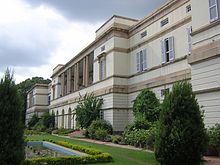- Teen Murti Bhavan
-
Teen Murti Bhawan Ex-PMO, India 
Residence of India's first Prime minister, Pt. Jawahar Lal NehruGeneral information Location Teen Murti Road Address New Delhi, India Coordinates 28°36′09″N 77°11′56″E / 28.602608°N 77.198774°ECoordinates: 28°36′09″N 77°11′56″E / 28.602608°N 77.198774°E Completed 1930 Design and construction Owner Government of India Architect Robert Tor Russel The Teen Murti Bhavan (Teen Murti House) is the former residence of the first Prime Minister of India, Jawaharlal Nehru in Delhi, India, who stayed here for 16 years until his death on May 27, 1964. It was designed by Robert Tor Russell, the British architect of Connaught Place and of the Eastern and Western Courts on Janpath during British Raj and built in 1930 as part of the new imperial capital of India, New Delhi, when it became the residence of the Commander-in-Chief of British Indian Army.[1]
Today, it houses various institutions including the Nehru Memorial Museum and Library (NMML), which runs under the Indian Ministry of Culture, and has Dr. Karan Singh as the chairman of its Executive Council. The complex also houses the offices of the 'Jawaharlal Nehru Memorial Fund', established in 1964 under the Chairmanship of Dr S. Radhakrishnan, then President of India.This house also contains the number of mementos from various nations including England, Nepal, Somalia, China etc which have great value to they're history. Each gift which has been given depicts the most noticable resource that the nations have.The foundation also gives away the prestigious 'Jawaharlal Nehru Memorial Fellowship', established in 1968.[2]
Also within the complex is the ‘Centre for Contemporary Studies’ and the Nehru Planetarium opened here in 1984.
Contents
Etymology
The house gets its name from the Teen Murti ("three statues") Memorial, which stands on the road junction in front of its extensive grounds. The memorial was built in memory of the Indian soldiers who perished in World War I.
History
The Bhavan was originally known as Flagstaff House and was the residence of the Commander-in-Chief of the British Forces in India. Designed by Robert Tor Russell, the chief architect of the PWD, the building sits amidst a vast estate. Built with stone and stucco, the building faces the south side of the Rashtrapati Bhavan (Presidents House). It has arched entrance, recessed window, and the first floor has a pillared veranda on the back on the building which overlooks the lawns.
After Independence (1947) the house was taken over as the residence of the Prime Minister. On Nehru's death in 1964, the house was converted into a national memorial comprising a library and a museum. Today, in a ground floor room of the Nehru Museum, his South Block office in the Ministry of External Affairs has been 'recreated' with the same furniture and other articles he used, along with several mementos, objects and manuscripts. The Nehru Memorial Library is one of the finest ones for information on modern Indian history.
The complex has headquarters of Jawaharlal Nehru Memorial Fund, (estb. 1964), Nehru Memorial Library, and also the Nehru Fellowship, also on the ground stand the Nehru Planetarium, inaugurated in 1984.
The Bhavan is closed to the public on Mondays and on all public holidays. One of the four Nehru Planetariums in India, is also situated in Teen Murti House. It was inaugurated by the then Prime Minister, Smt. Indira Gandhi, on February 6, 1984. The planetarium's sky theater is used for screening shows and as a gallery.[3] The planetarium was reopened in September 2010, after renovations worth Rs. 11 crore, ahead of the 2010 Commonwealth Games and received Queen's Baton. It now has 'Definiti optical star projector “Megastar” that can show 2 million stars. [4]
Details
Address - Teen Murti Marg, New Delhi Phone - +91-11-23015268 Shows - 11.30 am & 3 pm
References
- ^ "Architectural marvels for the new capital". Hindustan Times. July 20, 2011. http://www.hindustantimes.com/News-Feed/newdelhi/Architectural-marvels-for-the-new-capital/Article1-723169.aspx.
- ^ History Jawaharlal Nehru Memorial Fund, Official website.
- ^ "Nehru Planetarium". Press Information Bureau, Govt. of India. October 2001. http://pib.nic.in/feature/feyr2001/foct2001/f171020012.html.
- ^ "Nehru Planetarium ready to receive the Queen's Baton". The Hindu. Sep 30, 2010. http://www.hindu.com/2010/09/30/stories/2010093054610200.htm.
External links
Categories:- Museums in Delhi
- Buildings and structures in Delhi
- Visitor attractions in Delhi
- Buildings and structures completed in 1930
Wikimedia Foundation. 2010.



